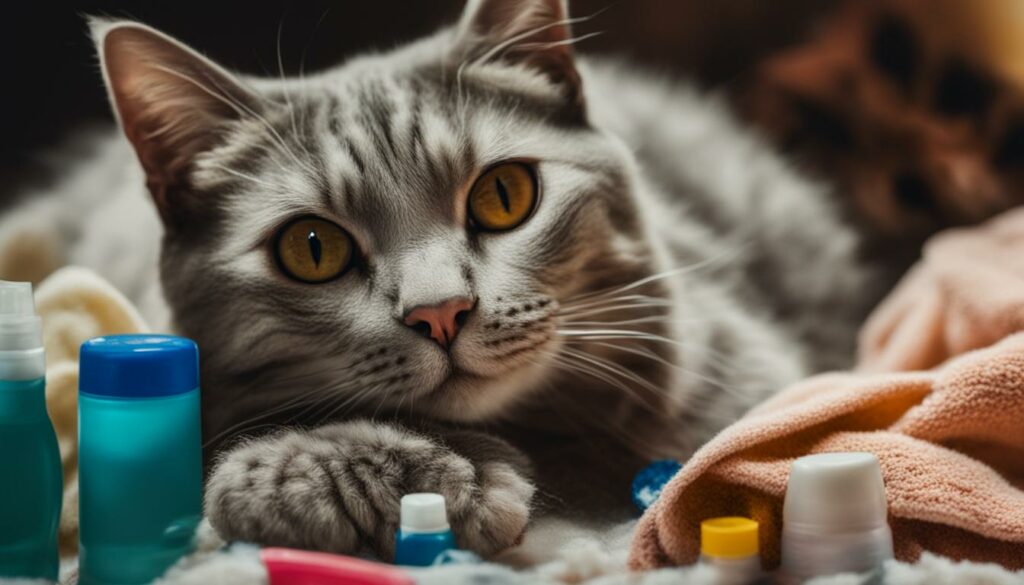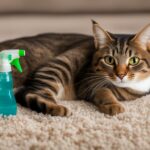Dealing with a cat urinating on themselves can be a messy and unpleasant situation. It’s important to handle the situation promptly to ensure your cat’s comfort and well-being. In this article, I will provide you with practical tips and recommendations for effectively cleaning your cat and maintaining their hygiene.
Accidents happen, but with the right approach, you can clean your cat and prevent future incidents. Let’s dive into the intricacies of cleaning your cat after they peed on themselves and explore the best practices to ensure their cleanliness.
Key Takeaways:
- Dealing with a cat urinating on themselves requires prompt action for their comfort.
- Understanding the causes of inappropriate urination can help prevent future incidents.
- Assessing the severity of the urine soiling helps determine the appropriate cleaning approach.
- A step-by-step guide to cleaning your cat includes bathing, removing stains, and using pet-friendly products.
- Maintaining a regular cleaning routine and litter box care is crucial for hygiene maintenance.
Understanding the Causes of Inappropriate Urination
When dealing with a cat urinating on itself, it is essential to understand the underlying causes before proceeding with the cleaning process. Inappropriate urination can occur due to various reasons, and identifying the cause is crucial in addressing the problem effectively and preventing future incidents.
Some common causes of inappropriate urination in cats include urinary tract infections, stress, territorial marking, or litter box issues. Cats may urinate on themselves as a result of discomfort or dissatisfaction in their environment. By understanding the cause, you can take appropriate measures to address the root problem and minimize the chances of recurrence.
It is recommended to consult with a veterinarian if your cat continues to have urine accidents on themselves or shows signs of distress. A vet can evaluate your cat’s health and provide guidance on managing any underlying medical conditions or behavioral issues that may be contributing to the problem.
By gaining a deeper understanding of the causes of inappropriate urination, you can take proactive steps to ensure your cat’s well-being and maintain a clean living environment.
Assessing the Severity of the Urine Soiling
When dealing with a cat that has peed on itself, it’s important to assess the severity of the urine soiling before determining the appropriate cleaning method. The severity will determine whether a simple surface clean or a more thorough cleaning routine is required.
If the urine is fresh and only on the surface, you may be able to clean it with absorbent pads, towels, or pet-friendly cleaning products. Gently blot the area with an absorbent pad or towel to remove as much moisture as possible. Be careful not to rub the urine into the fur or fabric, as this can spread the odor and stain.
On the other hand, if the urine has soaked into the fur or fabric, a more comprehensive cleaning routine may be necessary. In these cases, you may need to wash the affected area with water and a mild pet-friendly soap or shampoo. Rinse thoroughly to ensure all the soap is removed, and then gently pat the area dry with a clean towel. Avoid using harsh chemicals or irritants that could be harmful to your cat’s skin.
| Cleaning Method | Severity of Urine Soiling |
|---|---|
| Absorbent Pads, Towels, or Pet-Friendly Cleaning Products | Fresh urine on the surface |
| Water and Mild Pet-Friendly Soap or Shampoo | Urine soaked into the fur or fabric |
Remember, it’s essential to address the severity of the urine soiling promptly to prevent any discomfort or potential health issues for your cat. By choosing the appropriate cleaning method based on the severity of the urine soiling, you can effectively clean your cat and maintain their hygiene.
Step-by-Step Guide to Cleaning Your Cat
Cleaning your cat after a urine accident is essential for their comfort and hygiene. Follow these step-by-step instructions to ensure effective cleaning:
Gentle Bathing with Pet-Friendly Shampoo
Start by giving your cat a gentle bath using a pet-friendly shampoo. Use lukewarm water and lather the shampoo, carefully massaging it into your cat’s fur. This will help remove urine stains and odor from their coat.
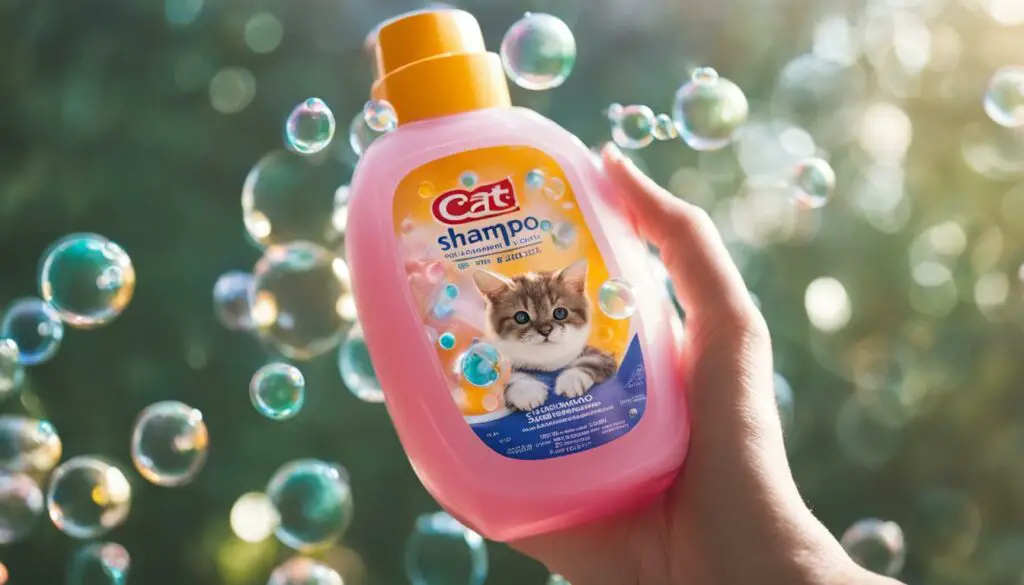
Rinse Thoroughly and Dry with a Towel
After shampooing, rinse your cat thoroughly to remove any traces of shampoo and urine. Make sure to rinse all areas, including the belly, paws, and tail. Once rinsed, use a clean towel to dry your cat gently. Avoid using a hairdryer, as it may cause stress to your pet.
Addressing Stubborn Stains or Odors
If there are stubborn stains or lingering odors, you can use pet-friendly stain removers or natural remedies. Mix equal parts vinegar and water to create a natural odor remover. Apply the mixture to the affected areas and let it sit for a few minutes before gently scrubbing with a soft cloth. Avoid using harsh chemicals or irritants that can harm your cat’s skin.
By following these steps, you can effectively clean your cat after a urine accident and keep them fresh and comfortable. Remember to always use pet-friendly products and be gentle during the cleaning process to ensure your cat’s well-being.
Dealing with Fur Matting
If your cat’s fur has become matted due to urine soiling, it’s important to address it promptly. Matting can cause discomfort and skin issues for your cat. To tackle fur matting effectively, you’ll need the right grooming tools and a gentle approach.
Grooming Tools for Untangling Mats
When dealing with fur matting, the right tools can make all the difference. A brush or comb specifically designed for detangling fur is essential. Look for tools with wide-spaced teeth or bristles to prevent unnecessary pulling or pain for your cat.
Untangling Mats Step-by-Step
To untangle mats, start by separating the hair gently with your fingers. Then, using a brush or comb, slowly work through the tangles from the edges, moving inward. Be patient and avoid pulling on the fur. If the mat is too stubborn, consider seeking professional grooming assistance to prevent any discomfort or potential injury to your cat.
Preventing Future Matting
Regular grooming sessions can help prevent matting from occurring in the first place. Make it a habit to brush your cat’s fur regularly, paying special attention to areas prone to matting such as the tail, paws, and belly. This not only helps maintain your cat’s appearance but also promotes a healthier coat and reduces the chances of urine soiling causing further matting.
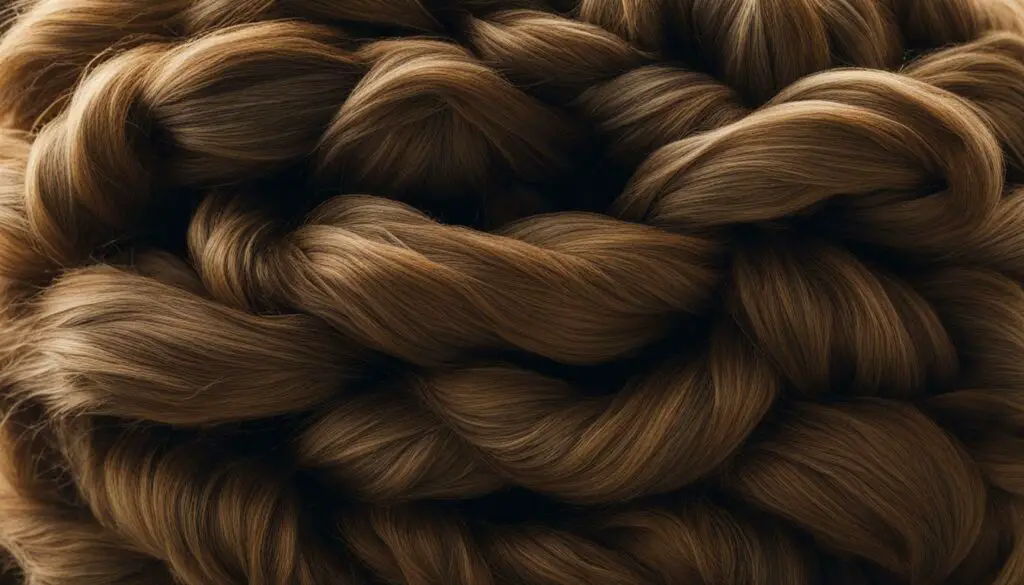
Grooming and maintaining your cat’s fur is crucial for their overall well-being. By following these tips and using the right grooming tools, you can keep your cat’s fur mat-free and ensure they stay clean, comfortable, and happy.
Maintaining a Regular Cleaning Routine
Keeping a regular cleaning routine is essential for maintaining your cat’s hygiene and preventing urine accidents. By following a few simple steps, you can ensure a clean and comfortable environment for your feline friend.
1. Clean the litter tray regularly
The litter tray is where your cat takes care of their business, so it’s crucial to keep it clean. Scoop out any waste and clumps from the litter box daily. This helps maintain cleanliness and prevents unpleasant odors from building up. Make sure to replace the litter completely on a regular basis as well. A fresh and clean litter tray will encourage your cat to use it regularly and minimize the chances of accidents.
2. Use a litter scoop
A litter scoop is a handy tool for keeping the litter box clean. Use it to remove any clumps or soiled litter promptly. This prevents the buildup of urine and feces, ensuring a clean and inviting environment for your cat. Regularly scooping the litter box also helps you monitor your cat’s urinary habits, allowing you to detect any potential health issues early on.
3. Establish a cleaning schedule
Set a regular cleaning schedule to ensure all areas frequented by your cat are clean and free of urine odor. This includes cleaning any soiled surfaces or fabrics, such as bedding or furniture, with pet-friendly cleaning products. Regularly vacuuming or sweeping the floors will also help remove any loose fur or debris. By sticking to a cleaning routine, you can maintain a fresh and hygienic living environment for your cat.
4. Consider odor control methods
To keep your home smelling fresh, consider using odor control methods. You can use pet-friendly air fresheners or odor eliminators specifically designed to neutralize cat urine odors. Additionally, ensuring proper ventilation in your home helps minimize any lingering smells. By implementing these odor control methods, you can create a pleasant and inviting space for both you and your cat.
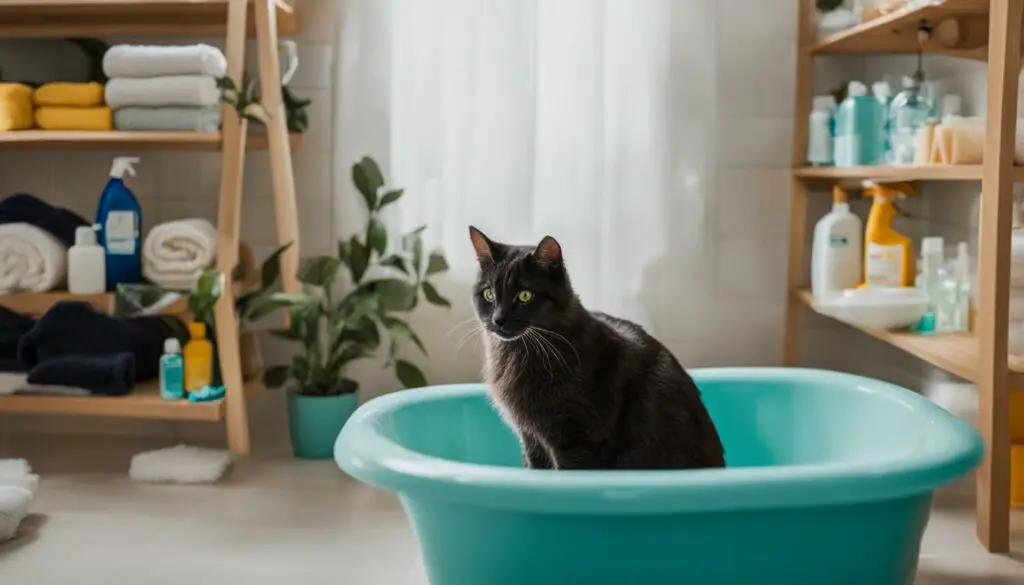
| Benefits of Maintaining a Regular Cleaning Routine |
|---|
| 1. Promotes a clean and hygienic environment for your cat |
| 2. Reduces the chances of urine accidents by encouraging regular use of the litter tray |
| 3. Helps monitor your cat’s urinary habits, allowing for early detection of any potential health issues |
| 4. Prevents the buildup of urine odor and fecal matter, keeping your home fresh and pleasant |
| 5. Creates a comfortable space for both you and your cat, promoting a harmonious living environment |
Using Absorbent Pads for Quick Cleanup
When dealing with a cat that has peed on themselves, quick and effective cleanup is essential. One practical solution is to use absorbent pads to prevent urine from soiling the surroundings. These pads are designed to quickly absorb liquid and lock away moisture, keeping your cat clean and dry.
To use absorbent pads, simply place one underneath your cat when accidents occur. The pad will absorb the urine, preventing it from spreading and causing further mess. This not only helps in maintaining cleanliness but also minimizes the risk of odor and potential contamination.
In addition to using absorbent pads, wet wipes can be handy for cleaning your cat’s paws and belly if they come into contact with urine. Wet wipes are gentle and convenient, making it easier to freshen up your cat without the need for a full bath. Ensure that the wipes you use are safe for pets and do not contain any harmful chemicals that could irritate the skin.
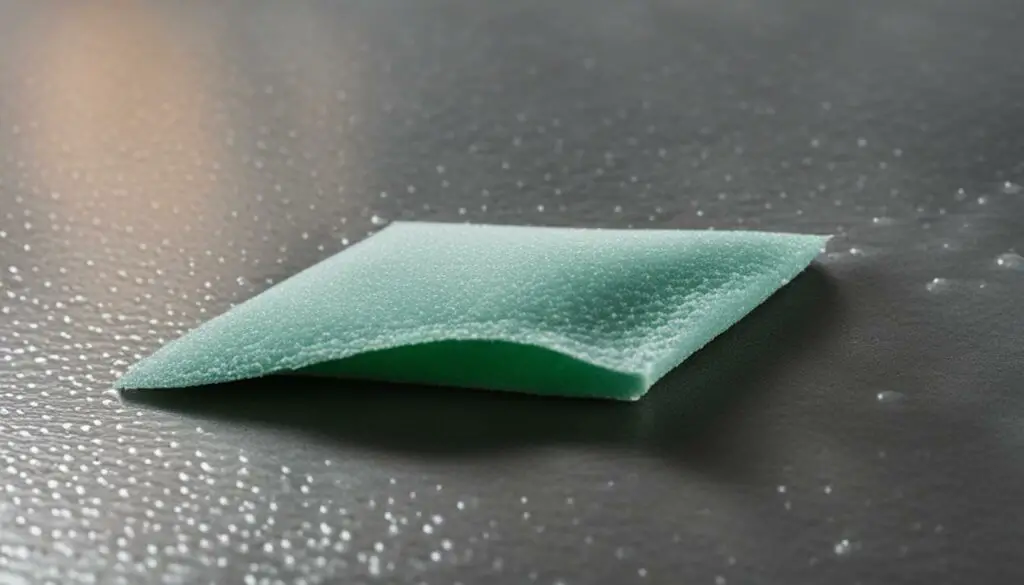
Benefits of Using Absorbent Pads:
- Prevents urine from soiling the surroundings
- Keeps your cat clean and dry
- Minimizes odor and contamination
By incorporating absorbent pads and wet wipes into your cleaning routine, you can tackle urine accidents effectively and maintain your cat’s hygiene with ease.
| Pros | Cons |
|---|---|
| Quick and convenient solution | May require frequent pad changes |
| Helps prevent urine from spreading | Not a long-term solution |
| Minimizes odor and potential contamination | Wet wipes may not be suitable for all cats |
Dry Shampoo for Freshening Between Baths
When it comes to keeping your cat clean and fresh, regular baths may not always be feasible or practical. This is where dry shampoo can be a great alternative for freshening up your furry friend between baths. Dry shampoo for cats is a convenient and effective way to remove dirt, oils, and odors from their coat without the need for water.
Dry shampoos for cats come in various forms, including powders and sprays. They are formulated to be safe for feline use and contain ingredients that help absorb excess oils and eliminate odors. To use dry shampoo, simply apply a small amount to your hand or a brush and gently massage it into your cat’s fur, focusing on areas that may be particularly dirty or smelly.
Using dry shampoo is especially beneficial for cats who dislike water or may have specific health conditions that make traditional bathing difficult. It’s important to choose a dry shampoo specifically designed for cats, as human products may contain ingredients that can be harmful to them. Always follow the instructions provided by the manufacturer and consult your veterinarian if you have any concerns.
“Dry shampoo for cats is a convenient and effective way to remove dirt, oils, and odors from their coat without the need for water.”
Benefits of Dry Shampoo for Cats
- Convenient alternative to traditional bathing
- Helps eliminate odors and refreshes the coat
- Can be used on cats who dislike water
- Great for senior cats or those with health conditions
- Quick and easy to use, saving time and effort
While dry shampoo can be a useful tool in keeping your cat clean, it should not replace regular baths entirely. It’s still important to provide your cat with proper grooming and hygiene maintenance. Regular brushing, nail trims, and dental care should all be part of your cat’s overall grooming routine.
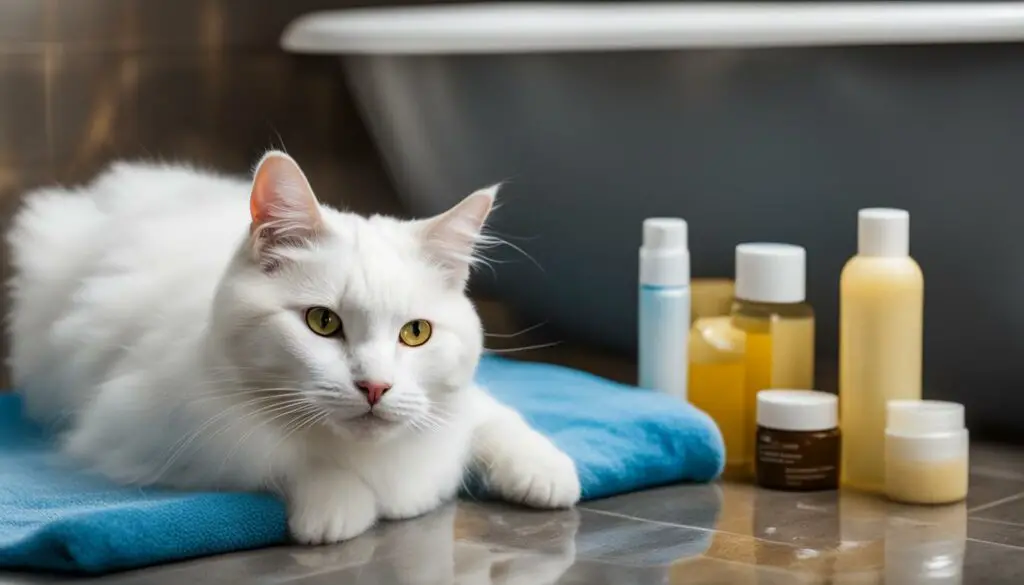
Using Enzyme Cleaners for Odor Control
When it comes to effectively eliminating urine odors and preventing future marking by your cat, enzyme cleaners are an invaluable tool. These specialized cleaners are designed to break down the odor-causing compounds present in cat urine, providing a more thorough and long-lasting solution than traditional cleaning products.
Enzyme cleaners work by utilizing enzymes, which are molecules that occur naturally and have the ability to break down specific substances. In the case of cat urine, these cleaners contain enzymes that target and break down the uric acid crystals that cause the strong smell. By effectively breaking down these compounds, enzyme cleaners not only remove the odor but also discourage your cat from returning to the same spot to mark or eliminate.
To use an enzyme cleaner, follow the instructions provided by the specific product. Generally, you will apply the cleaner directly to the affected area and allow it to sit for a specified period of time to ensure thorough penetration and enzymatic action. After the recommended time has passed, blot or rinse the area according to the instructions. It’s important to note that enzyme cleaners may require multiple applications for heavily soiled areas or particularly stubborn odors.
| Benefits of Enzyme Cleaners for Odor Control | Drawbacks of Enzyme Cleaners for Odor Control |
|---|---|
|
|
When using an enzyme cleaner, it’s important to choose a product specifically formulated for pet urine odors. Additionally, always test the cleaner on a small, inconspicuous area before applying it to the entire surface to ensure it doesn’t cause any adverse reactions or discoloration.
By using enzyme cleaners for odor control, you can effectively eliminate urine odors and discourage your cat from repeating the behavior. Remember to always follow the instructions provided by the product manufacturer and be patient, as it may take multiple applications to completely eradicate the odor. With regular cleaning and the use of enzyme cleaners, you can create a fresh and odor-free environment for both you and your cat.
Laundering Fabric Items
When your cat has soiled fabric items such as bedding or clothing, it’s important to tackle the issue promptly and effectively. Proper laundering techniques can help remove stains and eliminate any lingering odors. Here’s a step-by-step guide on how to launder fabric items:
- Pre-treat stains: Before washing, pre-treat any visible stains with a cat-friendly stain remover. Gently dab the stain remover onto the affected area and allow it to sit for a few minutes to break down the urine residue.
- Choose the right detergent: Select a mild detergent suitable for the fabric type. Avoid using bleach or strong chemicals, as they may cause discoloration or damage to the fabric.
- Check fabric care instructions: Refer to the fabric care label on the item to determine the appropriate washing temperature and cycle. Follow the instructions to ensure the best results.
- Load the washing machine: Place the soiled fabric items into the washing machine, making sure not to overload it. This will ensure proper agitation and cleaning.
- Wash on a suitable cycle: Select a cycle that is appropriate for the fabric type and the level of soil. Use warm or hot water for whites and heavily soiled items, and cold water for delicate fabrics.
- Drying: After washing, either tumble dry the fabric items on a low heat setting or air-dry them outdoors. Make sure they are completely dry before using or storing them to prevent musty odors.
By following these steps, you can effectively clean and refresh your cat’s soiled fabric items, restoring them back to their original cleanliness and freshness. Remember, maintaining a clean environment for your cat is essential for their overall well-being and hygiene.
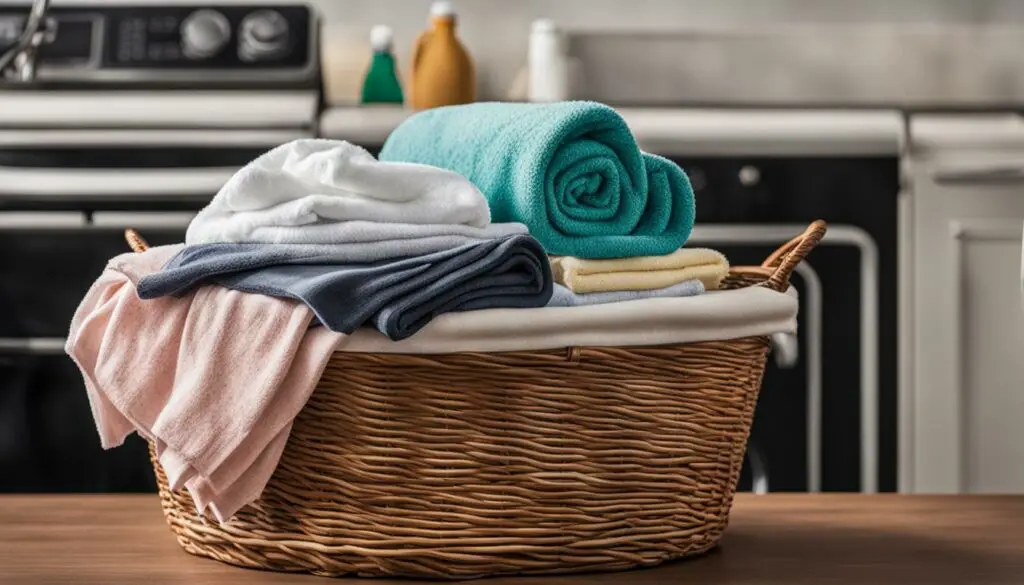
Maintaining a Clean Living Environment
When it comes to caring for your cat, cleanliness is key. A clean living environment is not only important for your cat’s health and well-being, but also for your own. By using the right cleaning products, practicing odor control, and regularly disinfecting your home, you can create a fresh and pleasant environment for both you and your furry friend.
Creating a Cleaning Routine
To maintain a clean living environment, it’s essential to establish a cleaning routine. This routine should include regular vacuuming, sweeping, and mopping of floors to remove any pet hair or debris. Use pet-friendly cleaning products that are safe for your cat to avoid any potential harm. Pay special attention to areas where your cat spends a lot of time, such as their bed or favorite lounging spots.
Additionally, regularly washing your cat’s bedding, blankets, and toys will help prevent the buildup of dirt and odors. Use a mild detergent that is safe for your cat’s sensitive skin and follow the care instructions for each item. If your cat has accidents on fabric surfaces, promptly clean and treat the area with an enzyme cleaner designed to eliminate odors.
Odor Control and Disinfection
Odor control is an important aspect of maintaining a clean living environment. Use pet-friendly air fresheners or odor-neutralizing sprays to keep your home smelling fresh and clean. Be mindful of using products that contain harsh chemicals or strong fragrances, as these can be overwhelming for your cat’s sensitive senses.
Regularly disinfecting surfaces that may have been soiled by urine accidents is crucial. Use pet-safe disinfectants or a mixture of vinegar and water to kill bacteria and eliminate odors. Pay close attention to litter box areas, where bacteria can accumulate. Ensure that the litter box is thoroughly cleaned and disinfected regularly to maintain proper hygiene.
| Cleaning Tips | Products |
|---|---|
| Regularly vacuum, sweep, and mop floors | Pet-friendly cleaning products |
| Wash your cat’s bedding, blankets, and toys | Mild detergent safe for cats |
| Use odor-neutralizing sprays or air fresheners | Pet-friendly products without harsh chemicals |
| Disinfect surfaces with pet-safe disinfectants or vinegar and water solution | Pet-safe disinfectants or vinegar |
| Regularly clean and disinfect the litter box | Litter box cleaner or mild detergent |
Maintaining a clean living environment for your cat is essential for their overall health and happiness. By establishing a cleaning routine, practicing odor control, and regularly disinfecting your home, you can create a comfortable and hygienic space for your cat to thrive.
Importance of Litter Box Care
Proper litter box care plays a crucial role in ensuring your cat’s hygiene and preventing them from peeing on themselves. By maintaining a clean and comfortable litter box, you can encourage your cat to use it regularly and avoid accidents. Here are some essential tips for litter box care:
Regular Cleaning:
Make it a habit to scoop the litter box daily, removing any clumps or waste. This helps keep the litter box clean and odor-free, creating a more appealing environment for your cat. Regular cleaning also prevents the buildup of bacteria, which can cause urinary tract infections or other health issues.
Litter Box Placement:
Choose a quiet and easily accessible location for the litter box. Cats prefer privacy when using the litter box, so avoid placing it in high-traffic areas or near noisy appliances. Additionally, keep the litter box away from their food and water bowls, as cats prefer to keep their elimination area separate from their eating area.
Provide Adequate Litter:
Ensure that the litter box is filled with an appropriate amount of litter. The litter should be deep enough for your cat to dig and cover their waste comfortably. Cats have a natural instinct to bury their waste, so providing enough litter allows them to follow this instinct and maintain good hygiene.
Consider Multiple Litter Boxes:
If you have multiple cats, it’s recommended to have multiple litter boxes as well. This prevents territorial disputes and ensures that each cat has easy access to a clean litter box. The general rule is to have one litter box per cat, plus an additional one as a backup.
| Benefits of proper litter box care: |
|---|
| Prevents your cat from peeing on themselves |
| Reduces the risk of urinary tract infections |
| Promotes good hygiene for your cat |
| Creates a comfortable and appealing elimination area |
| Prevents territorial disputes among multiple cats |
By prioritizing litter box care and following these tips, you can create a clean and inviting space for your cat to do their business. Remember, a well-maintained litter box is essential for your cat’s overall well-being and hygiene.
Section 13: Seeking Veterinary Advice
If you find that your cat continues to have urine accidents on themselves or displays signs of distress, it is crucial to seek professional advice from a veterinarian or pet expert. They will be able to assess your cat’s overall health and provide guidance on managing any underlying medical conditions or behavioral issues that may be causing the problem.
A veterinarian can conduct a thorough examination to determine if there are any underlying health concerns such as urinary tract infections or bladder problems. They can also provide guidance on behavioral modifications or training techniques to address any litter box issues or stress-related urination problems.
Additionally, a veterinarian can recommend specific cleaning products or treatments that are safe for your cat and effective in removing urine stains and odors. They can offer tailored advice based on your cat’s individual needs and help you develop a personalized plan for maintaining your cat’s hygiene and preventing future accidents.
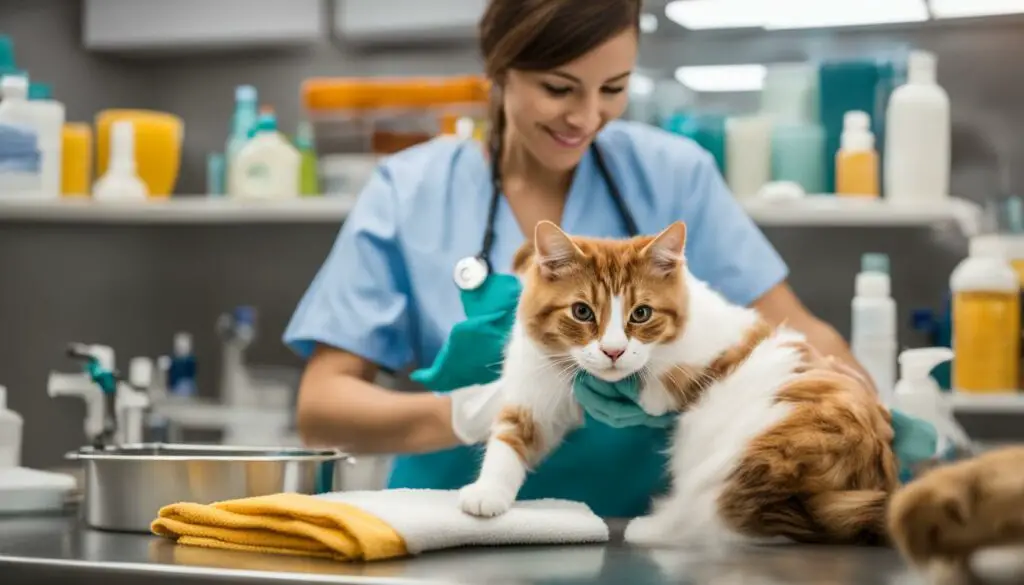
Remember, a veterinarian’s expertise is invaluable when it comes to your cat’s health and well-being. Don’t hesitate to reach out to them for professional advice and support. They will be able to provide the necessary guidance to ensure that your cat receives the best possible care.
Tips for Preventing Urine Accidents
Preventing urine accidents in cats requires proactive measures to ensure their hygiene and well-being. By implementing the following tips, you can minimize the chances of your cat peeing on themselves:
- Provide a clean litter box: Regularly clean the litter box and remove any waste or clumps. Cats are naturally clean animals and prefer a fresh and accessible litter box.
- Litter box training: For kittens or newly adopted cats, litter box training is essential. Show them where the litter box is located and encourage them to use it by gently placing them inside.
- Maintain proper hygiene: Regular grooming and hygiene practices are crucial for preventing urine accidents. Keep your cat’s fur clean and mat-free to minimize the risk of urine soiling.
- Address territorial issues: If you have multiple cats, ensure that each cat has their own designated litter box. This can help prevent territorial disputes and inappropriate urination.
Remember, cats may pee on themselves due to medical issues or stress. If you notice persistent urine accidents or behavioral changes, consult a veterinarian for guidance and support.
By taking preventive measures and providing a clean and comfortable environment, you can help ensure your cat’s happiness and hygiene. With proper care and attention, you can minimize the chances of urine accidents and create a stress-free environment for your feline companion.
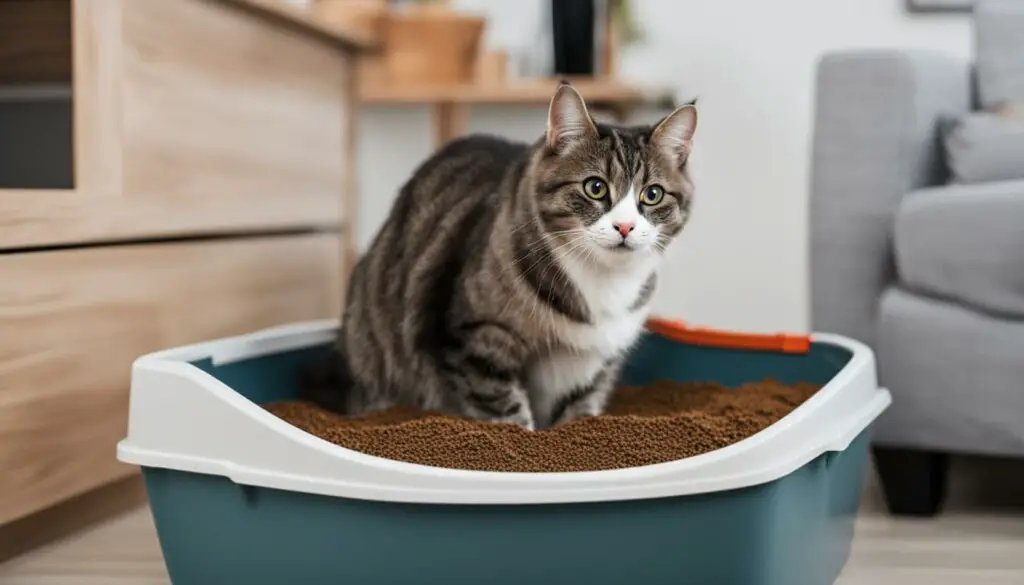
Preventing Urine Accidents: A Proactive Approach
Preventing urine accidents in cats requires a proactive approach to maintain their litter box hygiene, provide proper training, and ensure regular grooming. By following these expert tips, you can minimize the risk of your cat peeing on themselves:
- Provide a clean and accessible litter box: Cats are clean animals, and a dirty litter box can discourage them from using it. Regularly clean the litter box and keep it in a quiet and easily accessible area.
- Create a litter box routine: Establish a routine for scooping the litter box and removing any waste. Cats thrive on routine, and a consistent litter box routine can prevent accidents.
- Train kittens and newly adopted cats: Proper litter box training is essential to prevent urine accidents. Show them the location of the litter box and encourage them to use it with positive reinforcement.
- Maintain regular grooming: Regular grooming helps prevent urine soiling and keeps your cat’s fur clean and mat-free. Brush your cat’s fur regularly to remove any tangles or debris.
- Address stress or medical issues: Cats may pee on themselves due to stress or underlying medical conditions. If your cat continues to have urine accidents despite preventive measures, consult a veterinarian for a thorough examination and guidance.
By implementing these preventive measures, you can create a comfortable and hygienic environment for your cat, minimizing the chances of urine accidents and ensuring their well-being.
Conclusion
Dealing with a cat urinating on themselves can be quite a challenge, but with the right approach and regular hygiene maintenance, you can effectively clean your cat and prevent future accidents. Remember, the key is to address any underlying medical issues or behavioral concerns with the help of a veterinarian.
By establishing a consistent cleaning routine and providing a clean and comfortable environment, you can ensure your cat’s well-being and hygiene. Keep their litter box clean and accessible, and consider litter box training for kittens or newly adopted cats.
Additionally, maintaining proper grooming practices and regularly checking for fur matting can help keep your cat comfortable and stress-free. If accidents do occur, use absorbent pads or wet wipes for quick cleanups, and consider using dry shampoo to freshen up your cat between baths.
Remember, prevention is key. Take proactive measures to minimize the chances of your cat peeing on themselves. Provide a clean and accessible litter box and prioritize their hygiene and training. This will go a long way in ensuring their comfort and well-being.
FAQ
What can cause a cat to urinate on themselves?
Common causes include urinary tract infections, stress, territory marking, or litter box issues.
How do I clean fresh urine on my cat’s fur?
You can clean it with absorbent pads, towels, or pet-friendly cleaning products.
What should I do if the urine has soaked into the fur or fabric?
A more thorough cleaning routine may be required, including gentle bathing and using pet-friendly stain removers or vinegar and water as a natural odor remover.
How should I address fur matting due to urine soiling?
Use a brush or comb to gently untangle the mats, starting from the edges and consider using specialized grooming tools designed to prevent and remove matting.
How often should I clean the litter tray?
Clean the litter tray frequently, removing any waste and clumps, and use a litter scoop to maintain cleanliness.
What should I do for quick cleanups of urine accidents?
Use absorbent pads underneath your cat to prevent soiling the surroundings and wet wipes to clean your cat’s paws and belly if they have come into contact with urine.
Can I use dry shampoo on my cat?
Yes, dry shampoo can be an excellent option for freshening up your cat between baths. Choose a cat-friendly dry shampoo and follow the instructions for application.
How can I eliminate urine odors?
Enzyme cleaners are specifically designed to break down the odorous compounds in cat urine. Follow the instructions on the enzyme cleaner product and apply it to the affected area.
How should I launder fabric items soiled with urine?
Pre-treat any stains with a cat-friendly stain remover before washing. Use a washing machine with a suitable detergent and ensure thorough drying to prevent musty odors.
How can I maintain a clean living environment?
Regularly clean and disinfect areas that may have been soiled by urine accidents. Use cat-friendly cleaning products and consider odor control methods to maintain a fresh environment.
What is the importance of litter box care?
Proper litter box care is crucial in preventing your cat from peeing on themselves. Clean the litter box regularly and provide multiple litter boxes if you have multiple cats.
When should I seek veterinary advice?
If your cat continues to have urine accidents or shows signs of distress, it’s essential to seek veterinary advice to address any underlying medical conditions or behavioral issues.
How can I prevent urine accidents in the future?
Provide a clean and accessible litter box, establish a regular cleaning routine, and maintain proper hygiene and grooming practices to minimize the chances of your cat peeing on themselves.
What is the importance of maintaining my cat’s hygiene?
Maintaining your cat’s hygiene is crucial for their comfort and well-being. It helps prevent skin irritations, infections, and keeps them clean and stress-free.

